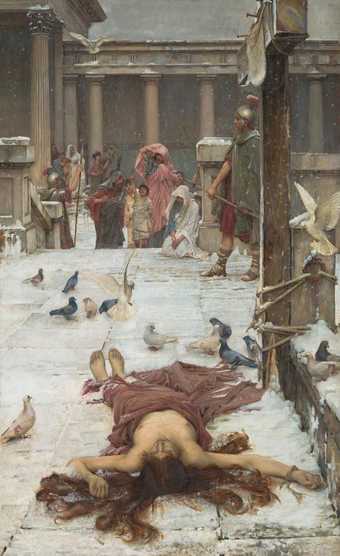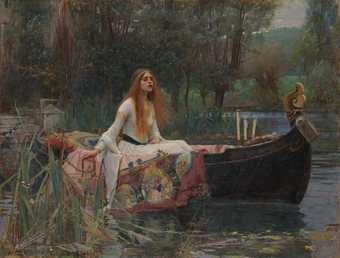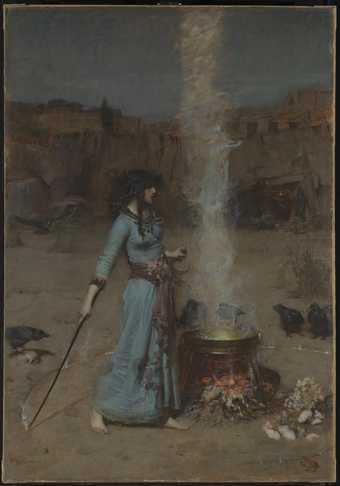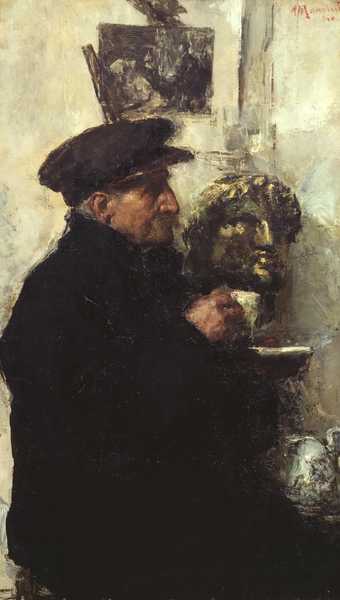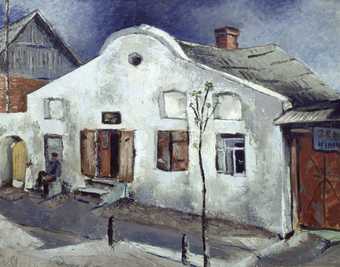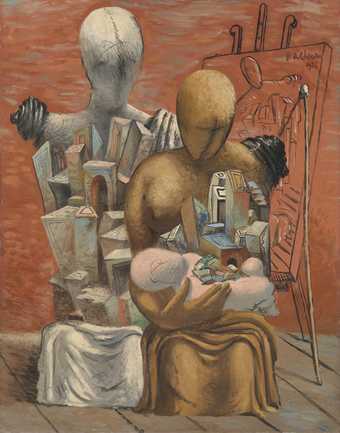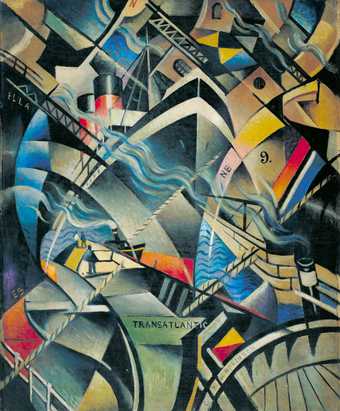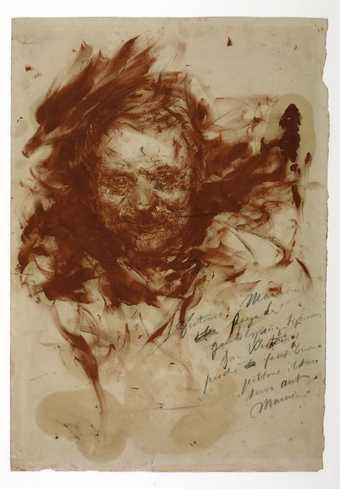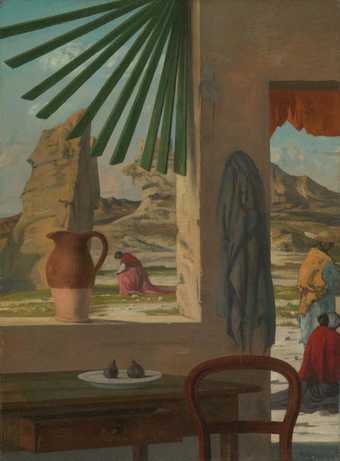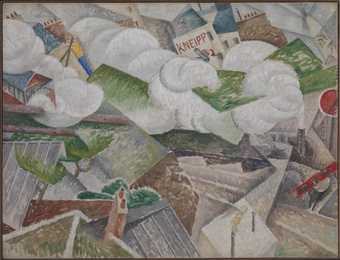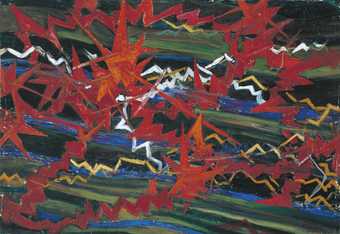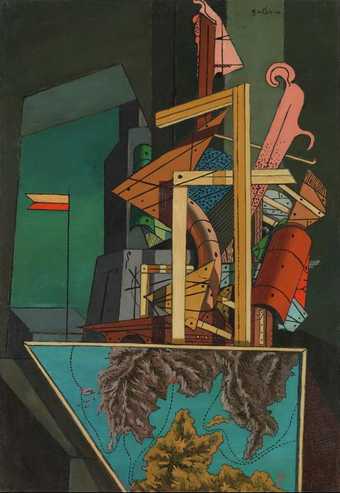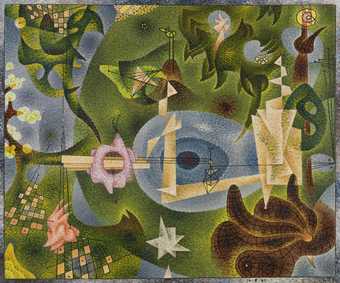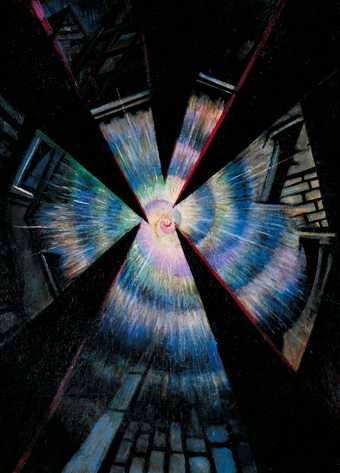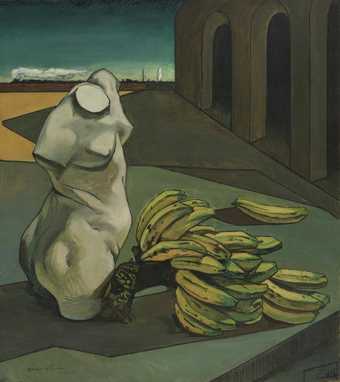
In Tate Liverpool
- Artist
- Giacomo Balla 1871–1958
- Original title
- Velocità astratta - l'auto è passata
- Medium
- Oil paint on canvas
- Dimensions
- Support: 502 × 654 mm
frame: 552 × 704 × 52 mm - Collection
- Tate
- Acquisition
- Presented by the Friends of the Tate Gallery 1970
- Reference
- T01222
Display caption
Ballà was a leading figure in the Italian Futurist group. He believed that the power and speed of machines such as cars were the salient characteristics of the modern age and aimed to express this idea in his work. This painting was originally the right-hand part part of a triptych. The left-hand part of the triptych was called 'Line of Force + Landscape' and the central one 'Lines of Force + Noise'. The theme of the triptych was the passage of a car along a white road, with green and blue forms, evoking earth and sky, in the background. The pinkish areas in this painting suggest the exhaust fumes left by the passing car.
Gallery label, September 2004
Does this text contain inaccurate information or language that you feel we should improve or change? We would like to hear from you.
Catalogue entry
Giacomo Balla 1871-1958
T01222 Abstract Speed - the Car has passed
1913
Inscribed 'BALLA' b.l., and 'N3' and 'VELOCITÀ ASTRATTA 1913 BALLA | - L'AUTO È PASSATA -' on back of canvas
Oil on canvas, 19 3/4 x 25 3/4 (50 x 65.5)
Presented by the Friends of the Tate Gallery 1970
Prov:
Luce and Elica Balla, Rome; Dr Pietro Campilli, Rome; with Marlborough Fine Art, London; Friends of the Tate Gallery 1963
Exh:
Omaggio a G. Balla Futurista, Origine, Rome, April 1950 (6); Futurism: Balla, Boccioni, Carrà, Russolo, Severini, Sidney Janis Gallery, New York, March-May 1954 (3); Futurism, Museum of Modern Art, New York, May-September 1961 (10, wrong work repr.); Detroit Institute of Arts, October-December 1961 (10, wrong work repr.); Los Angeles County Museum, January-February 1962 (10, wrong work repr.); Aspects of Twentieth-Century Art, Marlborough Fine Art, London, July-August 1962 (2, repr.); Giacomo Balla, Galleria Civica d'Arte Moderna, Turin, April 1963 (116, repr.); on loan to the Tate Gallery from 1963 until presented
Lit:
Maria Drudi Gambillo and Teresa Fiori, Archivi del Futurismo
(Rome 1962), Balla No.64a, Vol.2, p.155
Repr:
Official Guide to the Tate Gallery
(London 1970), p.27; The Tate Gallery 1970-72
(London 1972), p.33 in colour
Signorina Luce Balla has written (letters of 8 and 28 February 1972) that this work formed part of a triptych entitled 'Abstract Speed'. The left-hand painting was 'Lines of Force + Landscape' (Archivi del Futurismo, Balla No.62), the central one 'Lines of Force + Noise' (Archivi del Futurismo, Balla No.118a) and this picture 'The Car has passed' was on the right. The theme of the triptych was the swift passage of a motor car along a white road with, in the background, a synthesis of green forms and the sky, made up of azure curves which rise from the earth. This motif is present in all three paintings: in the first, on the left, are superimposed 'lines of force' (pinkish red) which evoke the speed of the passing car. In the second, in the centre, on the same motif of the road, the landscape and the sky are superimposed lines of force (red), together with criss-crossed forms and strident oppositions of colour symbolising the noise of the car; these expand to fill the entire picture. In the third (the Tate Gallery's work) there remains the white road, the landscape, the sky and the pinkish exhaust which gives a vague sensation of the car that has passed.
The central picture, now in the Peggy Guggenheim Foundation in Venice, was painted in 1912 and is in oil on millboard, 50.5 x 72.5cm in a painted frame 2.8cm wide. (The main lines of the composition are continued over the frame). Both the outer pictures are dated 1913 and are in oil on canvas, 50 x 65.5cm. The left-hand picture is inscribed on the back 'N2' and the Tate's picture 'N3'. (The central picture has no number, unless there is one under a label). It would seem therefore that the central picture was done first and that the two outer pictures were made afterwards probably as an afterthought, in order to show the stages leading up to and following this moment. Whereas the outer pictures are very similar to one another in style and treatment, the central painting is much more dense and complex, and represents a distinctly earlier phase. According to Signorina Luce Balla, the three pictures were hung fairly close together but with a little space between them, though no exhibition of the three as a group has yet been traced. As Balla sold the central picture to the painter Theo van Doesburg as early as 1915, he does not seem to have regarded them as very successful as a triptych, and probably came to the conclusion that they were better on their own. The two outer pictures remained in his possession until 1950, when the left-hand picture was bought from the exhibition at Origine in Rome by Prof. Dr William Löffler of Zurich.
Signorina Balla added that T01222 originally had a frame made by her father (presumably a painted frame), but unfortunately this seems to have been lost.
Published in:
Ronald Alley, Catalogue of the Tate Gallery's Collection of Modern Art other than Works by British Artists, Tate Gallery and Sotheby Parke-Bernet, London 1981, pp.29-31, reproduced p.29
Explore
- abstraction(8,615)
-
- from recognisable sources(3,634)
-
- landscape(1,191)
- non-representational(6,161)
-
- irregular forms(2,007)
- townscapes / man-made features(21,603)
-
- road(1,228)
- formal qualities(12,454)
- transport: land(2,189)
-
- car(502)
You might like
-
John William Waterhouse Saint Eulalia
exhibited 1885 -
John William Waterhouse The Lady of Shalott
1888 -
John William Waterhouse The Magic Circle
1886 -
Antonio Mancini Portrait of the Artist’s Father
c.1903–4 -
Niklavs Strunke The Town of Kraslava
1937–8 -
Giorgio de Chirico The Painter’s Family
1926 -
Christopher Richard Wynne Nevinson The Arrival
c.1913 -
Antonio Mancini Self-Portrait
c.1906 -
Eugène Berman The Jug on the Window
1934 -
Gino Severini Suburban Train Arriving in Paris
1915 -
Gerardo Dottori Explosion of Red on Green
1910 -
Giorgio de Chirico The Melancholy of Departure
1916 -
Gordon Onslow-Ford A Present for the Past
1942 -
Christopher Richard Wynne Nevinson Bursting Shell
1915 -
Giorgio de Chirico The Uncertainty of the Poet
1913

